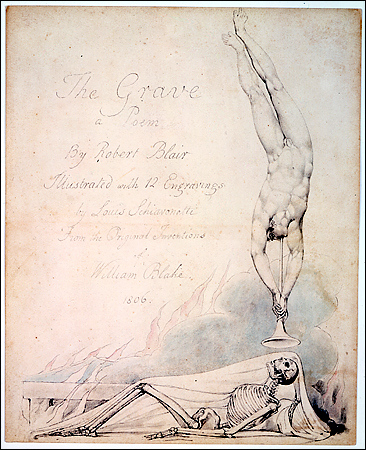Illustration for Robert Blair's The Grave

The connotation of the 'Caverns of the Grave' is the depths of the unconscious including depression and despair. Ahania and Enion are in the vicinity of the Caverns of the Grave when they wander near the borders of non-entity. Ironically despair and hope are both seen is this world of darkness. There is an implication that confrontations take place in 'Caverns of the Grave' which result in rebirth. Twice Blake juxtapositions 'Caverns of the Grave' with 'places of Human Seed' which must represent a deep level of the ability to recreate at the human or imaginative level.
As when the thunderbolt down falleth on the appointed place
Fell down down rushing ruining thundering shuddering
Into the Caverns of the Grave & places of Human Seed
Where the impressions of Despair & Hope enroot forever
A world of Darkness. Ahania fell far into Non Entity"
Four Zoas, Page 90, 91, SECOND PORTION) (E 363)
"The Prester Serpent ceasd the War song sounded loud & strong
Thro all the heavens Urizens Web vibrated torment on torment
Thus in the Caverns of the Grave & Places of human seed
The nameless shadowy Vortex stood before the face of Orc
The Shadow reard her dismal head over the flaming youth
With sighs & howling & deep sobs that he might lose his rage
And with it lose himself in meekness she embracd his fire
As when the Earthquake rouzes from his den his shoulders huge
Appear above the crumb[l]ing Mountain. Silence waits around him
A moment then astounding horror belches from the Center
The fiery dogs arise the shoulders huge appear
So Orc rolld round his clouds upon the deeps of dark Urthona
Knowing the arts of Urizen were Pity & Meek affection
And that by these arts the Serpent form exuded from his limbs
Silent as despairing love & strong as Jealousy"
Four Zoas, PAGE 122 [108], (E 383)
"Tharmas on high rode furious thro the afflicted worlds
Pursuing the Vain Shadow of Hope fleeing from identity
In abstract false Expanses that he may not hear the Voice
Of Ahania wailing on the winds in vain he flies for still
The voice incessant calls on all the children of Men
For she spoke of all in heaven & all upon the Earth
Saw not as yet the Divine vision her Eyes are Toward Urizen
And thus Ahania cries aloud to the Caverns of the Grave
Will you keep a flock of wolves & lead them will you take the wintry blast
For a covering to your limbs or the summer pestilence for a tent to abide in
Will you erect a lasting habitation in the mouldering Church yard
Or a pillar & palace of Eternity in the jaws of the hungry grave
Will you seek pleasure from the festering wound or marry for a Wife
The ancient Leprosy that the King & Priest may still feast on your decay
And the grave mock & laugh at the plowd field saying
I am the nourisher thou the destroyer in my bosom is milk & wine
And a fountain from my breasts to me come all multitudes
To my breath they obey they worship me I am a goddess & queen
But listen to Ahania O ye sons of the Murderd one"
Four Zoas, Page 113 [109], (E 384)
"These are the Visions of My Eyes the Visions of Ahania
Thus cries Ahania Enion replies from the Caverns of the Grave"
Rahab reaches a point of transformation when she hears 'Ahania weeping on the Void', and 'Enions voice sound from the 'caverns of the Grave'. Rahab, as Mystery, is burned with fire but her subsequent form, Deism, is raised from the ashes.
Four Zoas, PAGE 115 [111], (E 385)
"Rahab triumphs over all she took Jerusalem
Captive A Willing Captive by delusive arts impelld
To worship Urizens Dragon form to offer her own Children
Upon the bloody Altar. John Saw these things Reveald in Heaven
On Patmos Isle & heard the Souls cry out to be deliverd
He saw the Harlot of the Kings of Earth & saw her Cup
Of fornication food of Orc & Satan pressd from the fruit of Mystery
But when she saw the form of Ahania weeping on the Void
And heard Enions voice sound from the caverns of the Grave
No more spirit remained in her She secretly left the Synagogue of Satan
She commund with Orc in secret She hid him with the flax
That Enitharmon had numberd away from the Heavens
She gatherd it together to consume her Harlot Robes
In bitterest Contrition sometimes Self condemning repentant
And Sometimes kissing her Robes & jewels & weeping over them
Sometimes returning to the Synagogue of Satan in Pride
And Sometimes weeping before Orc in humility & trembling
The Synagogue of Satan therefore uniting against Mystery
Satan divided against Satan resolvd in open Sanhedrim
To burn Mystery with fire & form another from her ashes
For God put it into their heart to fulfill all his will
The Ashes of Mystery began to animate they calld it Deism
And Natural Religion as of old so now anew began
Babylon again in Infancy Calld Natural Religion"
In the late stages of the Four Zoas, as grief is being transformed to joy, the 'caverns of the Grave' is once more a symbol of the rebirth for 'those risen again from death '.
Four Zoas, Page 135, 136, (E 404)
"All round the heavenly arches & the Odors rose singing this song
O terrible wine presses of Luvah O caverns of the Grave
How lovely the delights of those risen again from death
O trembling joy excess of joy is like Excess of grief
So sang the Human Odors round the wine presses of Luvah "
.








